7. From Shrine to Stage: A Personal Account of the Challenges of Archiving the Tejaji Ballad of Rajasthan
DOI: 10.111647/OBP.0032.08.
The story of Tejaji
Tejaji is a snake deity widely revered by the agrarian community throughout Rajasthan, parts of Madhya Pradesh, and Gujarat. According to popular belief, he was born in the village of Kharnal of Nagaur district (historically known as Marwar state) of Rajasthan during the tenth century AD1 probably to a Jat (community) family. The story goes that he was married very early as an infant and was unaware of the fact until he grew to adolescence. One day, goaded by his sister-in-law, he learnt about his married status and so resolved to visit his wife’s village and bring her home. Before doing so he first went to his sister’s village to bring her back and then left to collect his wife. He encountered many bad omens as he started his journey but continued undeterred. It is this interesting journey to his wife’s village and his encounter with the snake to whom he gives his life that form the content of the sung Tejaji Ballad.
The Tejaji Ballad
The Tejaji Ballad occupies an important part of the sung oral tradition in Rajasthan.2 The singers are non-professionals who have built up expertise through years of continuous performances at Tejaji shrines. The tradition is not caste- or community-specific: the singers and devotees come from all sections of society, small Tejaji shrines exist in every village and different fairs and festivals mark the importance of the deity. During the Tejaji fair, the performance of the ballad is the most important of all the rituals performed at the shrine. A separate style of Tejaji performance also exists in the region in the form of khel3 enacted on stage as a serial drama over several nights, but this has almost died out.
In its original form, men come together at night to sing the Tejaji Ballad during the monsoon months. This period used to be spread over two months but increasingly the performances only begin close to the main festival of Teja-Dashmi which marks the end of the season.
The aim of the performance of the ballad is to induce the spirit of Tejaji to enter the priest (Bhopa)4 so that he can exorcise snake poison from man or beast. The possibility of encountering snakes is highest during the monsoon when the ballad is sung. The narration of the ballad supports a strong belief that whoever ties a thread in the name of Tejaji will survive the snakebite. Traditionally, the singers are called upon to perform whenever an urgent case of snakebite arises or when an offering is made for the fulfillment of a wish. The ballad symbolises reverence to the deity for life. Thus the performers, performance and the Bhopa are strictly related to the shrine of Tejaji and these cannot be separated.
Traditionally, the singing of the Tejaji Ballad takes place at the village shrine with the singers and instrumental players sitting on the ground facing each other in a circle. In the majority of modern performances, two men sing the ballad accompanied by a few others. In one village, people remembered groups of up to fifty men facing each other. One initiates the basic lines of the ballad and the other repeats them. The accompanying musical instruments used are dholak,5 algoza,6 manjira7 and also hand clapping (Figure 1). The recordings hosted by the World Oral Literature Project, and made in Thikarda village, were done in this traditional style with these instruments. There are very few men left who can play the algoza and it is a dying craft.
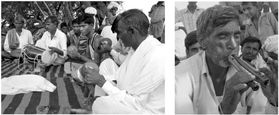
Figures 1 and 2. Accompanying instrumental players. The algoza is being played in Figure 2. The player is using a continuous stream of breath and does not need to punctuate the music with breaths. Photograph by Madan Meena, 2010.
Iconography
The Tejaji Ballad illustrates the sacrificial deed of Tejaji. It establishes his ideal human character in keeping his promise. During the narrative of the ballad, the character Tejaji loses his life in obedience to his promise to a snake whilst on a journey to bring his wife home. The snake bites him on the tongue as this is the only place still unbloodied after his heroic adventures. The ballad is infused with local references to make it more relevant to the present-day life of the people, for example the singers mention a flood in the Kali Sind river when Tejaji goes on a pilgrimage to Badrinath shrine. Geographically, Badrinath lies in the Himalayas (north India), while Kali Sind is a local river in the Hadoti region.8
The popular image of Tejaji is as a warrior sitting on a mare holding a spear in his hand and with the snake climbing up to bite him (see Figure 3). This image is found in calendars, cassette covers, shrine paintings, and in stone reliefs.9 In the village of Sureli in Tonk district, the Bhopa imitates the incident of the snake biting his tongue on the occasion of the Teja-Dashmi festival,10 at which the crowds go wild. I was able to video-record this moment for the archives but was not able to get a good sound recording because of extraneous noises and the general chaos.
A day prior to the eve of Teja-Dashmi, the Bhopa moves in a procession sitting on a mare holding the snake round his neck. The next day he allows the snake to bite him on his tongue. For a moment after the snake bites he appears to lose consciousness but is brought back to life by the crowd singing Tejaji songs. At the end of the festival, in the evening, the snake is released into its hole. The Bhopa who performs this is quite old and his successors may not be able to follow it in future. This performance is a unique enactment in the whole of Rajasthan.
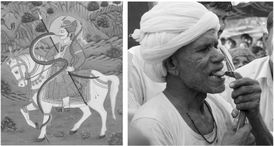
Figure 3. Iconic image of Tejaji represented in a painting. Painted by Gopal Soni, Bundi. Photograph by Madan Meena, 2010.
Figure 4. A Bhopa of the Tejaji Shrine in Sureli, Tonk, imitating a snake-bite with a real Cobra on the occasion of Teja-Dashmi festival. Photograph by Madan Meena, 2010.
During the current project, the full twenty hours of the Tejaji Ballad were recorded, transcribed into the local Hadoti language, and translated into Hindi and English as part of fieldwork supported by the World Oral Literature Project. The final objective was to publish a book along with an audio DVD, which were freely distributed these among the singers, villagers, schools and libraries in the area. This will help in preserving the ballad for future generations.
The main singers in my recordings are of the Mali11 community of Thikarda12 village (Figure 5) situated near Bundi town in the Hadoti region. The recordings were made during the monsoon season in 2010 at the local Tejaji shine outside the village, and at night to avoid external disturbances. Though the ballad can be sung at any part of the day when the need arises to invoke the spirit of Tejaji, it is usually sung at night-long jagarans.13 The singers and the instrumental players were mostly in their late fifties and sixties. The young generation was generally absent from the jagarans, as with easy availability of other entertainment options they are not interested in these traditional performances. Recording the complete ballad took six night-long sessions spread over two months. The musicians cannot sing on consecutive nights as they are too exhausted and it was always a challenge to fix up the next recording session and to collect the same group of performers.
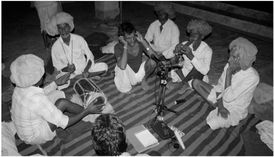
Figure 5 Tejaji singers of the Mali community at village Thikarda. Photograph by Madan Meena, 2010.
Alongside Thikarda village, recordings were made in some twenty-four other villages in the Hadoti region and adjoining areas in order to get a sense of the variations and nuances in styles.
Challenges of recording
In many villages, the singing is so endangered that it only happened because I was commissioning it. The singers are now limiting its performance to around the main festival of Teja-Dashmi. The quality of the recordings was affected by the fact that instruments needed repair and vocalists were out of practice.
The performers do not think of themselves as individuals and do not like to be singled out by name. They see themselves as being interchangeable and as part of a performance. This was a challenge for recording, as I wanted the same musicians each time to maintain continuity for archiving purposes but they did not see this as important.
I was trying to record a full version of a twenty-hour Tejaji Ballad spread over several nights in as genuine a context as possible. Thikarda village is now the only village in which singers are able to perform the whole ballad. Increasingly, sections are sung when a jagaran is called. As snakebites are completely unpredictable it was difficult to be there when a genuine performance was happening, to try to capture and understand the difference in intensity of performance between one called when a life was at stake, and one called for archiving purposes. I was at a shrine once when a buffalo was brought with a snake bite and it died in front of me.
On occasions when someone else had organised the performance I had little influence over the time and venue and, if there was heavy rain, the performance would be cancelled at the last minute. If the performance was carried out, the spirit might not come for several hours and it was hard to keep the musicians going and for myself to stay awake through the recording session. The most successful recording sessions in terms of sound quality were those which I commissioned myself although the authenticity was compromised.
I recorded on thirty-six nights out of sixty in August and September 2010. For a genuine performance, a jagaran has to be called and a feast thrown.14 This involves ghee and puja15 material as well as beedis16 and endless cups of tea for the musicians and the audience. At one recording, I provided refreshments for one hundred people (Figure 6). This was not the norm, however, and the problem was to attract an audience. In such performances a local audience is necessary as they are the real patrons. They boost the performers by responding to the music and this interaction becomes part of the performance. The singer and musicians would sing for thirty minutes to an hour with intermediate breaks for smoking, chewing tobacco and drinking tea. The performance was exhausting and therefore the instrument players took turns, but these supporting players tended to fall asleep after being tired from agriculture work. This wasted valuable time on many occasions as I was trying to keep the same performers throughout the recordings for the integrity of the archive. At the end of a session, they would have to be shaken awake.
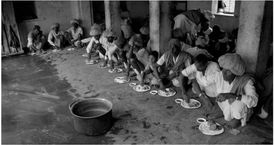
Figure 6. Thikarda singers having a feast of daal-baati17 and churma18 after the jagaran. Photograph by Madan Meena, 2010.
The performance is traditionally carried out until the spirit of Tejaji enters the Bhopa. However, the spirit often would not come until 4:00am and the singers had to keep going in turns until it happened. Once the Bhopa’s body is possessed by the spirit of the deity, his voice and behaviour change and he acts as the deity himself, and addresses the problems of the devotees. At one village called Nayagaon near Bundi, because of the many hours that had passed and the spirit had not come, all the musicians fell asleep and I had to give up for the night.
Another challenge was to collect the musicians in the first place. If a jagaran is called they have to come, but I would always have to wait two or three hours each time to gather them at the shrine despite all prior contacts and invitations having been made. If it rained heavily, the event would be cancelled or moved inside where recording became impossible because of sound resonance and beedi smoke.
To record at one of the villages inhabited by the Kanjar community, notorious for its illegal activities and crime, I had to take a police escort. Everyone in the village was drunk, including the instrumental players. But the performance turned out to be fabulous and was participated in by women dancers, which I had not seen before (Figure 7). The performers moved in a colourful procession, which went round the village the whole night finally culminating in a frenzied gathering at the Tejaji shrine in the morning. During the performance it was not just one Bhopa, but many who all took turns to be possessed by local deities. Some of the performers had passed out by the morning from their excesses.
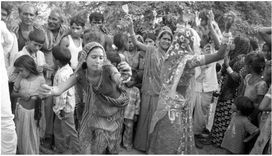
Figure 7. Kanjar women dancing to the tune of the Tejaji Ballad. Photograph by Madan Meena, 2010.
Having worked with the more sober Thikarda singers last year, I was able to gain their confidence. It is not traditional to pay them individually but to donate something for the shrine. In return for the six recording sessions, the shrine has new paintings and a cement floor outside, on which villagers can perform under a tree. The village has decided that it wants money towards a roof for the new cement floor and I have promised Rs. 20,000.19
At the end of the recordings during the Teja-Dashmi mela (local fair) I called the performers and honoured each with a flower garland and a dhoti.20 They appeared to be satisfied, but with other groups it was different. Some groups assumed that I was going to make money out of the recordings and therefore demanded a high fee and travel expenses. Others wanted me to publish cassettes and CDs for them in return for playing. Very few could understand the concept of the recordings being for academic and archiving purposes.
During recording sessions at many places, the singers could not be motivated to sing without the installation of a sound system. They have become so accustomed to microphones that the pitch and volume at which they sing has considerably reduced. They feel uncomfortable singing without the microphones. Impractically, they especially like to listen to themselves during the performance by tilting one of the loudspeakers towards themselves. With the use of microphones and amplifiers, the singers do not have to exert themselves. The empathy between the singer and the instrumental players is lost. An external person controls the blend and volume of the ballad by monitoring and adjusting the input signal levels whereas in the absence of any amplifying equipment, the singers and players have to listen to each other and adjust their volume accordingly.
For authentic recordings, the loudspeakers and amplifiers were a big hurdle (Figures 8 and 9). They generate lots of echo and extra sound in the background. Also the spontaneity is not present in such microphone-supported performances. In such situations, I cancelled my recordings so as not to disturb the jagaran called by the villagers.
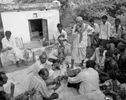
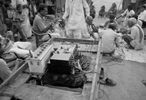
Figures 8 and 9. Singers holding the microphone, and an amplifier installed on a cart. Photograph by Madan Meena, 2010.
From shrine to stage
Over the years, a shift in tradition has lead to stage performances. One reason for this is the popularity of religious Hindu bhajan21 performances on stage. The Tejaji singers are evolving their style accordingly. They are moving out from the confines of the community to larger prominence, seeking audiences despite the challenge of influences from outside. This type of performance was not worth recording for the purposes of my project but it is a very important trend and will lead to the loss of genuine performances and opportunities to record in the future.
The repertoire is losing its strength on stage. When the group sings the Tejaji Ballad at a village shrine, it is sung in consecutive mode, and the story progresses in linear manner. On stage, multiple groups participate and the time duration is short, thus only a popular part of the ballad is sung. The audience is very diverse, and the aspect of entertainment is more important than belief. Thus the singers, dancers and electronic equipment and instruments dramatise the performance: the objective is shifting from honouring the deity to gathering accolades of the audience.
One reason for the evolution of a stage style is the desire of the middle class development lobby to provide a platform for the dying rural traditions. Musicians are invited to urban or even international platforms and encouraged to devise a short programme that will fit into the constraints of a planned set-piece entertainment. Under the name of “Hadoti Culture”, the audience is treated to an overblown, overdressed Bollywood-style parody of the Tejaji tradition with even a female singer backing up the storyteller. There is always a prancing horse dancer and usually a man twirling an umbrella. The audience, which probably does not understand the language of the singing, is introduced only to the visual elements. For generations the traditions of the Tejaji Ballad have survived in the environment of socio-religious beliefs and customs. Only time will tell how far the stage will carry them and in which direction.
Thus from this perspective of rapid changes to the Tejaji Ballad, the authentic traditional style is losing ground. Most of the performers are aged and the new generation is not interested in learning the tradition. The modern values of education do not support the belief in Tejaji. At the present time, no one who has been to school likes to tie a thread in the name of Tejaji if bitten by a snake. He or she will immediately rush to the hospital to get the anti-venom treatment. This is obviously a good development but it means that the old oral tradition is so under threat that my recording may be the last occasion on which the ballad is sung in its entirety.
The challenges of recording the Tejaji Ballad for archiving purposes, and for offering the ballad in a pure form to the people of Hadoti, have been many and varied but, for the most part, successfully met and personally, it has been a most rewarding experience. As proposed, the twenty hours of the ballad with Thikarda singers was recorded successfully in its original style keeping in mind the technical archival standards. This project has opened doors to further recordings in other villages as people themselves have welcomed me to record their groups. They are beginning to understand the value of archiving such traditions. Once the singers are recorded they are very keen to get a copy of it immediately after the recording. With the aid of computers and bluetooth devices they download it to their cellphone handsets and mp3 players. I hope that this will help in popularising this tradition if not as a belief system then at least as a singing tradition. Thus, after this project the future effort will be to record and archive as many Tejaji Ballad singing groups as come forward, and to produce on-demand audio DVDs for them. The urgency to record the different styles of the ballad prevalent in different parts of Rajasthan has been very apparent during the project. I plan to concentrate on archiving them with support from outside or independently.
The audio-video and written records of this project will serve as a snapshot of cultural heritage for the future, but will also constitute a fossilised archive of a constantly changing important Hadoti oral tradition. Hopefully this will serve as a model for archiving similar traditions prevalent in Rajasthan, which are also on the verge of extinction. Apart from archiving it, the publication of the book and audio DVD will help in promoting its value and importance amongst the younger generation.
References
Bharucha, Rustom, Rajasthan, An Oral History: Conversations with Komal Kothari (New Delhi: Penguin Books, 2003).
Deshraj, Thakur,Jat Ithihas (Delhi: [n. pub.] 2002).
Government of India, Survey of India Maps (India [n.p.]: Government of India, 1998).
Meena, Madan, Tejaji Gatha (Kota, Rajasthan: Kota Heritage Society, 2012).
Tod, James,Annals & Antiquities of Rajasthan, 2 vols (India: Rupa & Co, 2002).
Online Sources
World Oral Literature Project, Madan Meena: Tejaji Gatha collection
<www.oralliterature.org/collections/mmeena001.html>
Footnotes
1See Thakur Deshraj (2002: 305).
2The tradition of Tejaji singing has traveled to the adjoining states of Madhya Pradesh and Gujarat through continuous migrations of the Raika (shepherd) community in search of pastoral lands. The Raikas are devotees of Tejaji and they sing the ballad in great reverence.
3These are types of dramas enacted in villages at nights during the festive time. Also called nautanki in north Rajasthan.
4A priest of the shrine who is also in charge of it. He possesses spirits of the deities and gives alms to villagers to aid with their problems.
5A barred-shaped double-headed drum played with hands on both sides.
6A double-flute producing a drone effect, played with fingers on both flutes simultaneously.
7Brass cymbals played with two hands in continuous rhythm.
8The region derives its name from Hada Rajputs who settled in the region in the twelfth century and dominated the area for several centuries thereafter. At one time, the Hada-ruled state of Bundi encompassed the present-day districts of Baran, Bundi, Kota, and Jhalawar. See James Tod (2002: 355). A map of the Hadoti region is available at <http://bit.ly/Z3wjey>.
9The earlier relief sculptures, found in old shrines of Tejaji (e.g. the Tejaji shrine in the village of Dugari in Bundi district), depict his image in a more abstract way. In later images (e.g. the Tejaji shrine at Balchandpara in Bundi), the detail is refined. These images of Tejaji are washed regularly and decorated with colorful foil and sindoor (vermillion) (Bharucha, 2003, for this and all other glossary terms) on dasse, i.e. on the tenth day of every Hindu Bhadwa month.
10The festival of Teja-Dashmi falls on tenth day of Bhadwa Hindu month i.e. in September. The day is marked with celebrations at Tejaji’s shrine, the cutting of the threads, and a number of important fairs. People fast on that day (they eat once in the evening), offer prasad (offerings) and hoist flags at the shrines.
11The Mali community are commonly recognised as gardeners in the whole of north India. Two main sub-castes of Mali exist in Rajasthan according to the interviews with the Thikarda Mali: those who are involved in the cultivation of flowers for the shrines and temples are called Phool-Mali, and those involved in agricultural practices and vegetable cultivation are called the Gheevar Mali. The Mali of Thikarda village are Gheevar Mali who have small land holdings (one acre on average) on which they grow vegetables and supply them to nearby Bundi town.
12The village Thikarda is situated ten kilometers from Bundi across the hills to the north. At one time it was a part of Bundi state. Today it has a population of some 5,000 people, mainly of the Mali community, followed by Kumhars (potters), Meghwals and Rajputs.
13Jagarans are all-night singing sessions where devotees gather at the shrine to listen to the musicians who sing devotional songs. The purpose of the Jagrans is to invoke the deity.
14All the recordings were carried out at Tejaji’s shrines by organising jagarans and feasts in honour of the deity. This was in order to maintain originality and the context of the tradition.
15Offering to the deity.
16Locally made cigarette by stuffing tobacco into a leaf pipe.
17Rajasthani village dish of wheat balls made and cooked in a cow-dung fire and eaten broken up and mixed with ghee and daal.
18Sweetened mixture of crushed baati served with daal-baati.
19Indian Rupee.
20Loin cloth worn by men.
21Generic term for devotional song.



